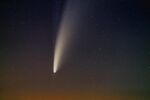Astronomy:PHL 293B: Difference between revisions
(over-write) |
(No difference)
|
Latest revision as of 10:43, 6 February 2024
Coordinates: ![]() 22h 30m 36.8s, −00° 06′ 37″
22h 30m 36.8s, −00° 06′ 37″
| {{{name}}} | |
|---|---|
| File:Color image of PHL 293B.tif Hubble Space Telescope image of PHL 293B; the purported luminous blue variable is located near the core of the galaxy | |
| Observation data (J2000 epoch) | |
| Constellation | Aquarius |
| Right ascension | 22h 30m 36.8s[1] |
| Declination | −00° 06′ 37″[1] |
| Redshift | 0.0051[1] |
| Distance | 74 Mly (22.6 Mpc)[2] |
| Apparent magnitude (V) | 16.87[3] |
| Apparent magnitude (B) | 17.35[3] |
| Characteristics | |
| Type | Im?[1] |
| Other designations | |
| Kinman's Dwarf, PGC 69018[3] | |
| Observation data Equinox J2000.0]] (ICRS) | |
|---|---|
| Constellation | Aquarius |
| Right ascension | 22h 28.1m[4] |
| Declination | −0° 22′[4] |
| Characteristics | |
| Evolutionary stage | Luminous blue variable? |
| Astrometry | |
| Radial velocity (Rv) | (of galaxy) 1,606[5] km/s |
| Distance | 22,600,000[2] pc |
| Details | |
| Radius | 1,348–1,463[6] R☉ |
| Luminosity | 2,500,000–3,500,000[6] L☉ |
| Temperature | 6,000–6,800[6] K |
| Other designations | |
| Database references | |
| SIMBAD | PHL 293B |
| PHL 293 (Simbad mistakenly showing results for PHL 293B) | |
PHL 293B, also known as Kinman's dwarf, is a low-metallicity blue compact dwarf galaxy about 22.6 Mpc from the Earth in the constellation Aquarius.[2]
It had a very likely associated, notable, blue-light, long-lived star with constant outbursts or a large supernova observed to have faded and which then disappeared. Although this bright visible jet-producing object responsible for broad hydrogen emission lines with P Cygni profiles was widely considered to be a luminous blue variable ejecting matter, other studies posited the mentioned, competing, explanations for the bright light source within.
Observation history
PHL 293 was first listed as entry 293 in a catalogue of faint blue stars published by Guillermo Haro and Willem Jacob Luyten in 1962.[9] In 1965, Thomas Kinman observed two faint possible companions to it, about 1′ away, which he dubbed A and B. HL 293B, sometimes called Kinman's Dwarf, was noted to be an extragalactic, nonstellar object, with a jet, approximately 22.6 Mpc away from Earth.[2][8] The acronym PHL has since been applied to distinguish it from other HL catalogues; it is most commonly referred to by astronomers as PHL 293B.[4] The galaxy was identified as a blue compact dwarf, a type of small irregular galaxy undergoing a strong burst of star formation.[7]
The spectrum of PHL 293B is unusual both for its low metallicity and for broad hydrogen emission lines with P Cygni profiles. These are interpreted as being from a large luminous blue variable star in the galaxy. The star is believed to have been undergoing an outburst during previous observations,[7] an interpretation is disputed by some publications.[citation needed] An alternative explanation would be a long-lived type IIn supernova, similar to the transient event of SDSS1133.[10] These emission features in the spectrum of the galaxy faded during 2019 and by the end of the year had disappeared (at least visibly), likely due to the disappearance of a bright star of the galaxy.[6]
See also
References
- ↑ 1.0 1.1 1.2 1.3 Kehrig, C.; Iglesias-Páramo, J.; Vílchez, J. M.; Gil De Paz, A.; Duarte Puertas, S.; Pérez-Montero, E.; Díaz, A. I.; Gallego, J. et al. (2020). "Mapping the ionized gas of the metal-poor H II galaxy PHL 293B with MEGARA". Monthly Notices of the Royal Astronomical Society 498 (2): 1638–1650. doi:10.1093/mnras/staa2299. https://eprints.ucm.es/id/eprint/63578/1/cardiel117preprint.pdf.
- ↑ 2.0 2.1 2.2 2.3 Kinman, T. D. (1965). "The Nature of the Fainter Haro-Luyten Objects". The Astrophysical Journal 142: 1241. doi:10.1086/148392. Bibcode: 1965ApJ...142.1241K.
- ↑ 3.0 3.1 3.2 "PHL 293B". SIMBAD. Centre de données astronomiques de Strasbourg. http://simbad.u-strasbg.fr/simbad/sim-basic?Ident=PHL+293B.
- ↑ 4.0 4.1 4.2 French, H. B. (1980). "Galaxies with the spectra of giant H II regions". The Astrophysical Journal 240: 41. doi:10.1086/158205. Bibcode: 1980ApJ...240...41F.
- ↑ Guseva, N. G.; Papaderos, P.; Meyer, H. T.; Izotov, Y. I.; Fricke, K. J. (2009). "An investigation of the luminosity-metallicity relation for a large sample of low-metallicity emission-line galaxies". Astronomy & Astrophysics 505 (1): 63–72. doi:10.1051/0004-6361/200912414. Bibcode: 2009A&A...505...63G.
- ↑ 6.0 6.1 6.2 6.3 Allan, Andrew P.; Groh, Jose H.; Mehner, Andrea; Smith, Nathan; Boian, Ioana; Farrell, Eoin J.; Andrews, Jennifer E. (2020). "The possible disappearance of a massive star in the low-metallicity galaxy PHL 293B". Monthly Notices of the Royal Astronomical Society 496 (2): 1902. doi:10.1093/mnras/staa1629. Bibcode: 2020MNRAS.496.1902A.
- ↑ 7.0 7.1 7.2 Izotov, Yuri I.; Thuan, Trinh X. (2009). "Luminous Blue Variable Stars in the two Extremely Metal-Deficient Blue Compact Dwarf Galaxies DDO 68 and PHL 293B". The Astrophysical Journal 690 (2): 1797–1806. doi:10.1088/0004-637X/690/2/1797. Bibcode: 2009ApJ...690.1797I.
- ↑ 8.0 8.1 Terlevich, Roberto; Terlevich, Elena; Bosch, Guillermo; Díaz, Ángeles; Hägele, Guillermo; Cardaci, Mónica; Firpo, Verónica (2014). "High-velocity blueshifted Fe ii absorption in the dwarf star-forming galaxy PHL 293B: Evidence for a wind driven supershell?". Monthly Notices of the Royal Astronomical Society 445 (2): 1449–1461. doi:10.1093/mnras/stu1806. Bibcode: 2014MNRAS.445.1449T.
- ↑ Haro, G.; Luyten, W. J. (1962). "Faint Blue Stars in the Region near the South Galactic Pole". Boletín de los Observatorios de Tonantzintla y Tacubaya 3: 37. Bibcode: 1962BOTT....3...37H.
- ↑ Burke, Colin J.; Baldassare, Vivienne F.; Liu, Xin; Foley, Ryan J.; Shen, Yue; Palmese, Antonella; Guo, Hengxiao; Herner, Kenneth et al. (2020). "The Curious Case of PHL 293B: A Long-lived Transient in a Metal-poor Blue Compact Dwarf Galaxy". The Astrophysical Journal 894 (1): L5. doi:10.3847/2041-8213/ab88de. Bibcode: 2020ApJ...894L...5B.
 |




